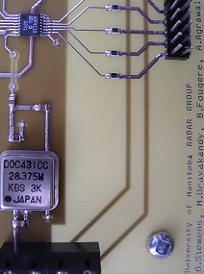| This
thesis presents the design, construction, and testing of a 1-3
GHz, Stepped-Frequency Continuous Wave (SFCW) radar system
capable of detecting human beings through walls. The design,
component selection, and implementation are detailed in such a
manner that the work herein is completely reproducible.
Specifically, the system is integrated such that a Personal
Computer (PC) controls the data acquisition and image
processing. This user-friendly system allows the user to
interact with the radar transceiver through a Graphical User
Interface (GUI) on the PC. The user is then capable of
controlling the radar hardware by sending appropriate commands
to a Peripheral Interface Controller (PIC) which, in turn,
controls the transceiver. The system acquires data in the form
of I & Q demodulated SFCW scans performed using a bi-static
antenna arrangement. For utmost accuracy, the radar is digitally
synthesized and controlled using Phase-Locked Loops (PLLs) as
the frequency sources. This digital control gives the user
flexibility in customizing the start and stop scan frequencies,
and the overall sweep time for a complete scan. Physical
compactness and robustness of the transceiver system has been
realized through the use of Surface Mount (SMT) components
fabricated entirely upon Printed Circuit Boards (PCBs). |


